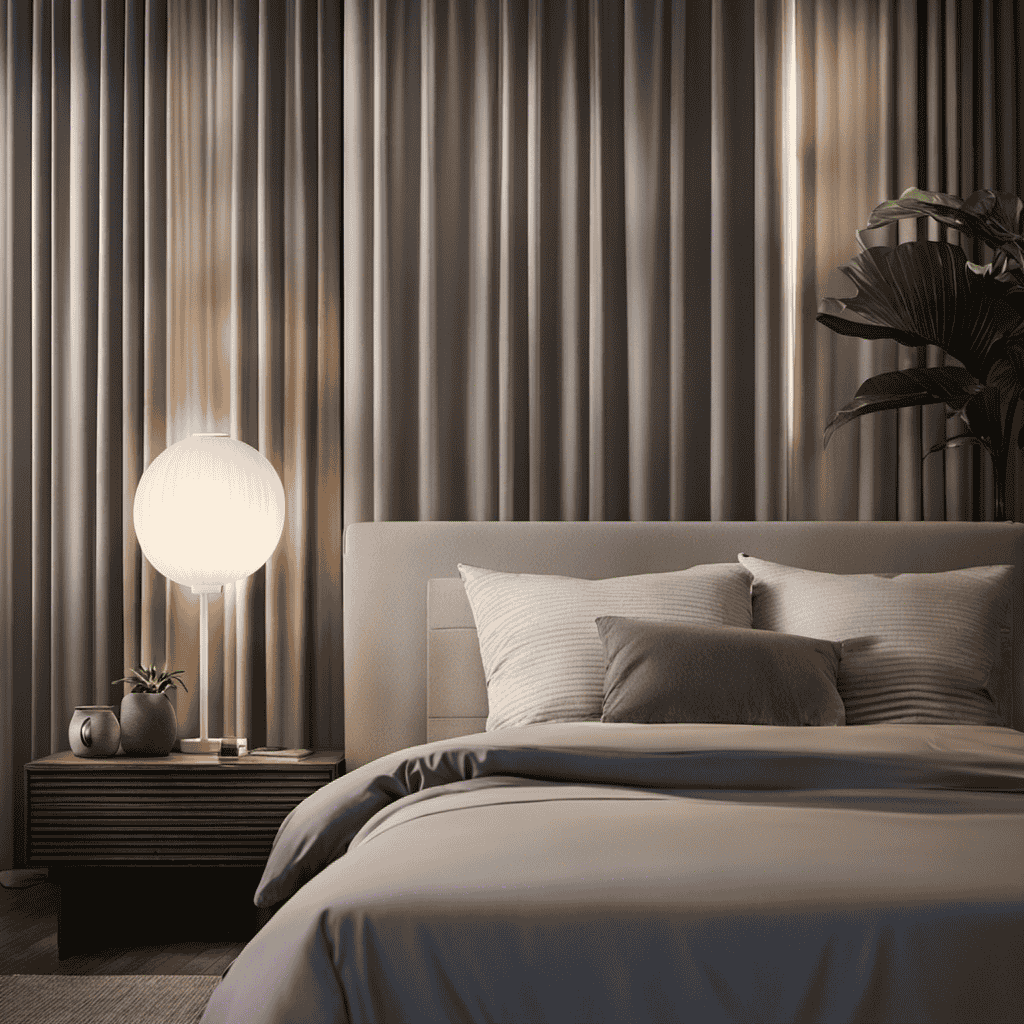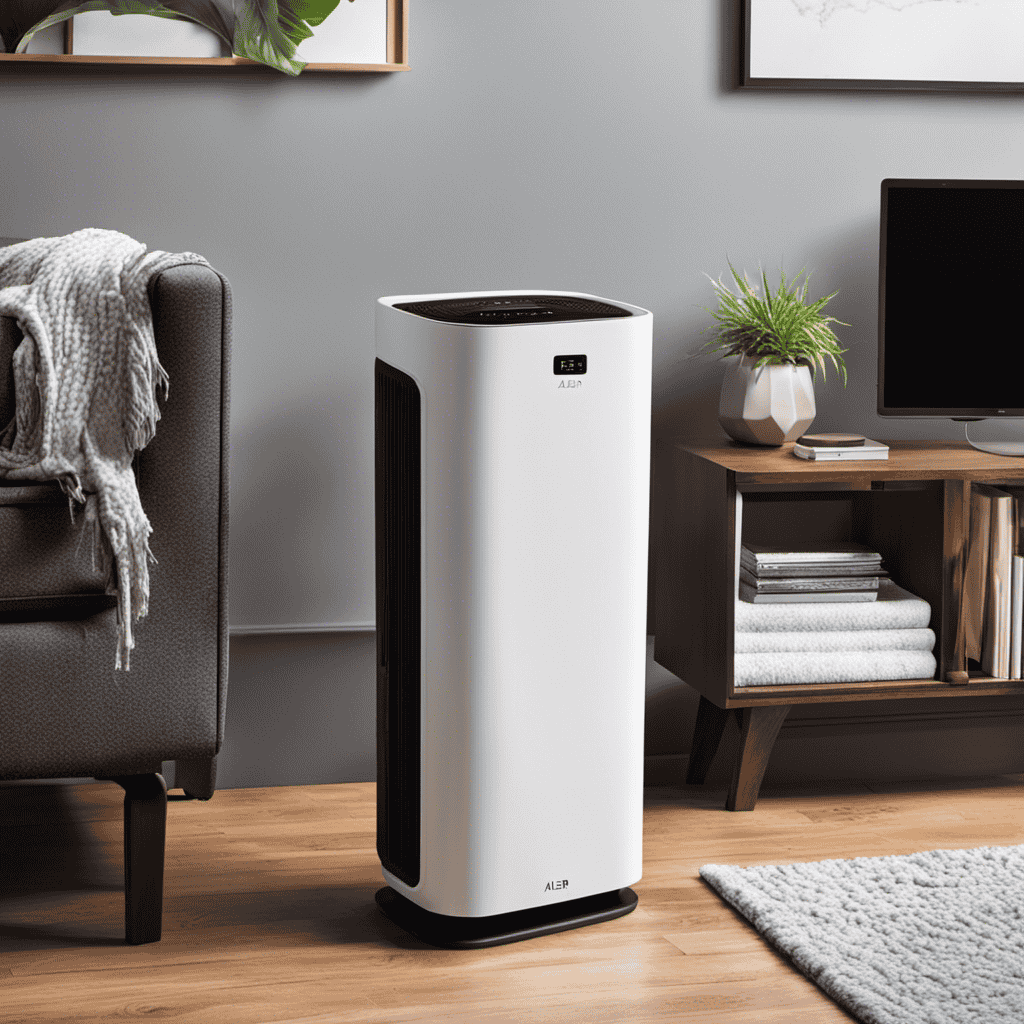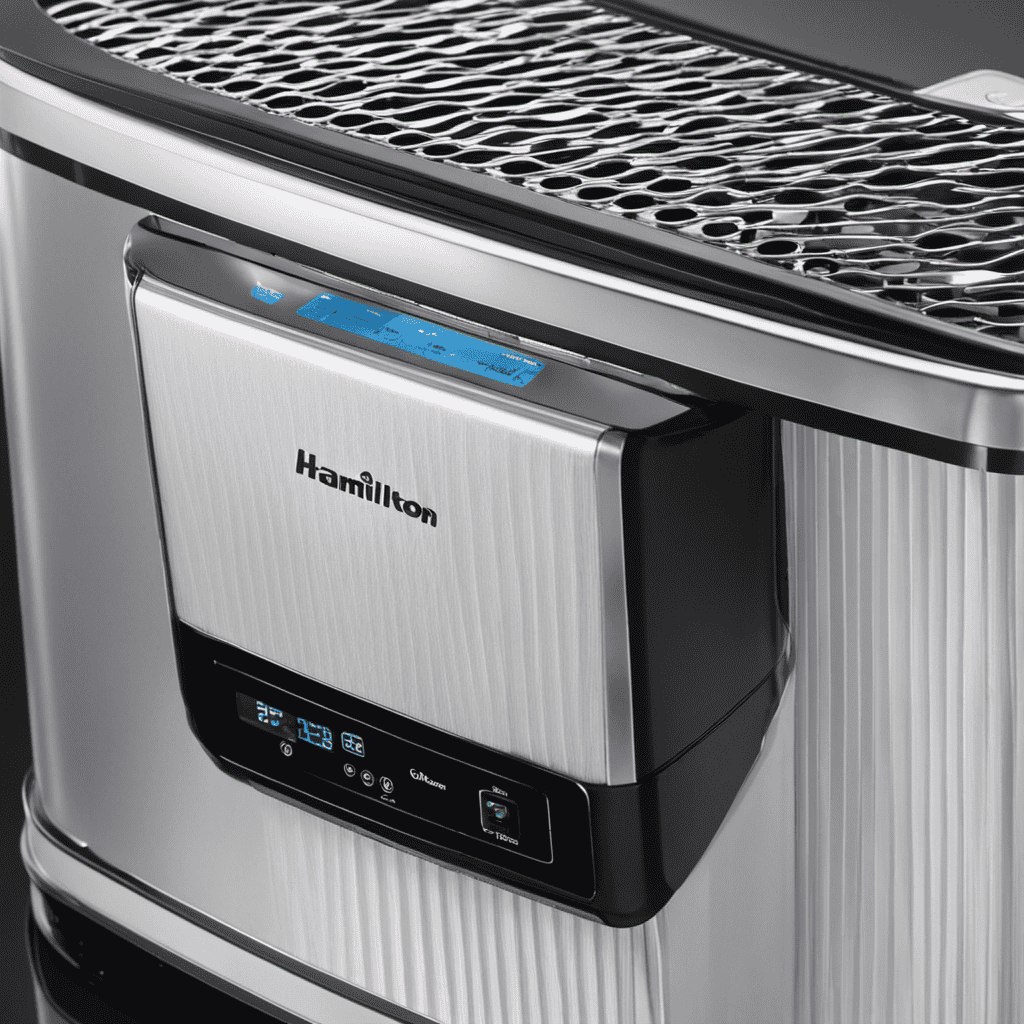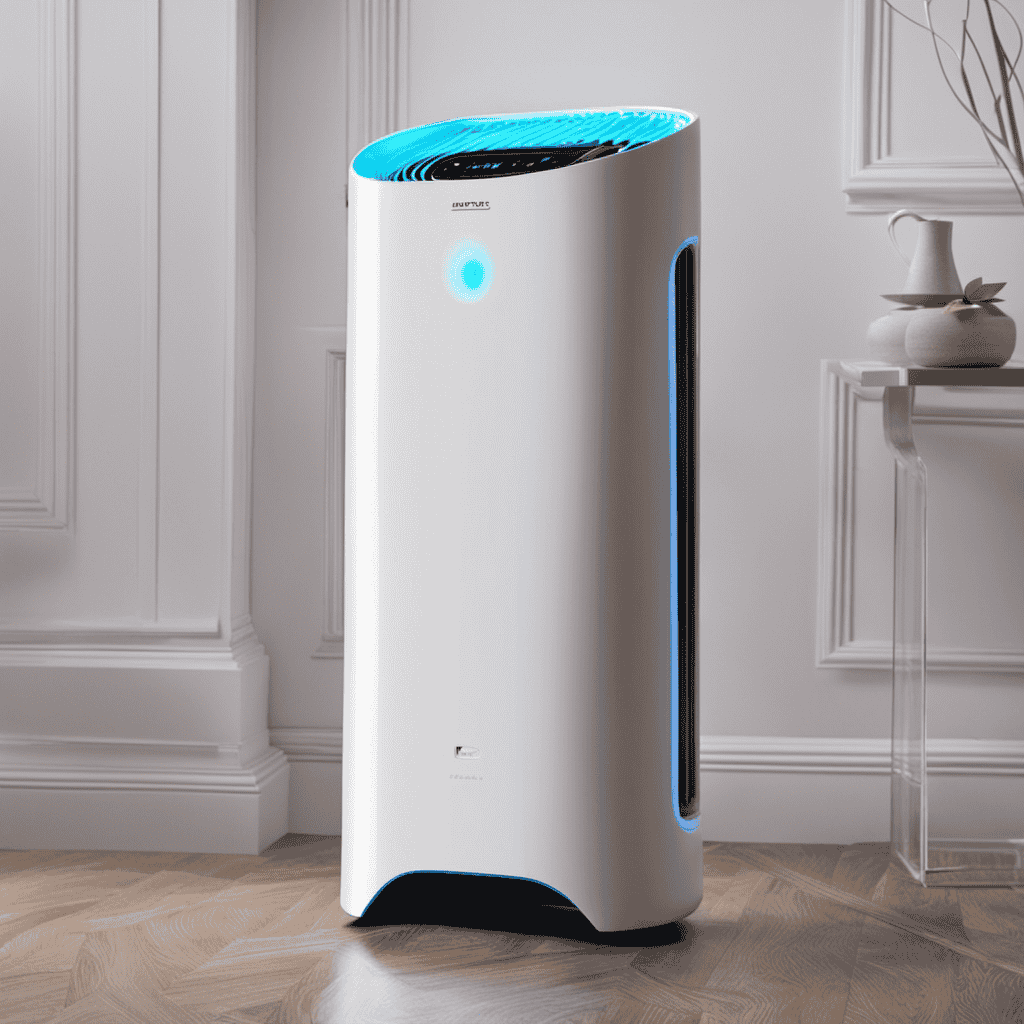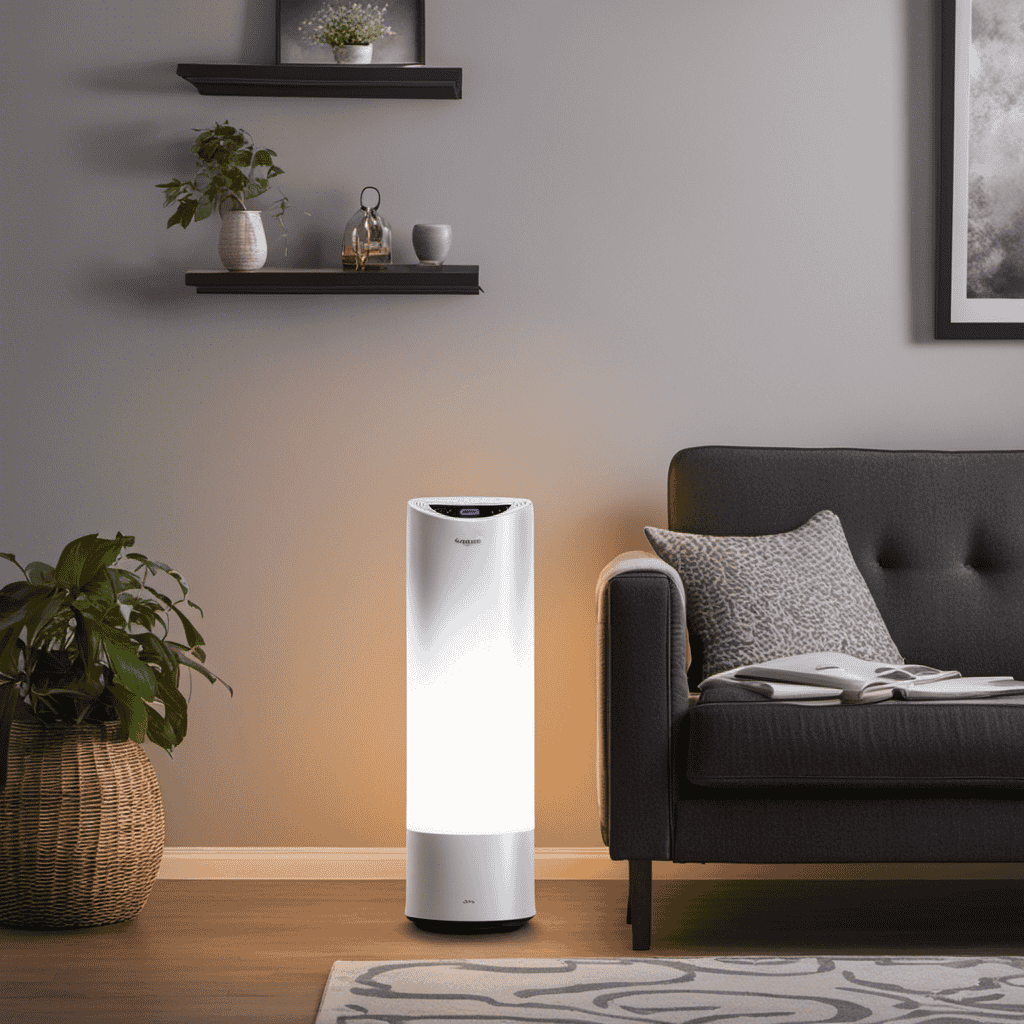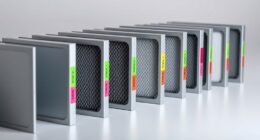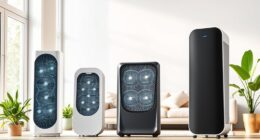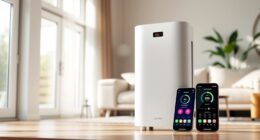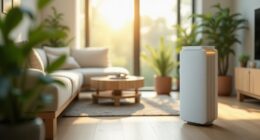In my quest to enhance the air quality in my bedroom, it’s crucial for me to position my air purifier in the optimal location. Indeed, a gulp of clean air is instrumental in fostering a serene and soothing environment for sleep.
In this article, I’ll guide you through the ideal placement for maximum efficiency, strategic positioning to target problem areas, and important considerations for allergy sufferers.
Let’s dive in and discover where to put an air purifier in the bedroom.
Key Takeaways
- Place the air purifier near the bed for optimal efficiency and better sleep quality.
- Position the air purifier away from obstructions such as walls, furniture, or curtains to ensure proper air circulation.
- Strategically place the air purifier to target problem areas in the bedroom, such as high traffic spaces or allergen-prone areas.
- Consider airflow and ventilation by keeping bedroom doors and windows open periodically and avoiding obstructions that block airflow.
Ideal Placement for Maximum Efficiency
The best spot to place an air purifier in your bedroom is near the bed for optimal efficiency. By placing the air purifier near the bed, you ensure that you are breathing in clean air while you sleep, which can greatly benefit your overall health and well-being.
Air purifiers work by filtering out pollutants, allergens, and other harmful particles from the air, creating a healthier environment for you to rest and rejuvenate. Additionally, having nearby plants can further enhance the air purification process as they naturally filter the air and release oxygen.
The combination of an air purifier and nearby plants can greatly improve the air quality in your bedroom, leading to better sleep and improved respiratory health.
Near the Bed for Better Sleep Quality
Placing an air purifier close to your bed can improve the quality of your sleep. Here’s why:
-
Better air quality: An air purifier filters out harmful pollutants like dust, pollen, and pet dander, ensuring cleaner air for you to breathe while you sleep.
-
Health benefits: Breathing in clean air can reduce the risk of respiratory problems, allergies, and asthma, leading to improved overall health.
-
Sound sleep: By removing airborne irritants, an air purifier creates a more peaceful environment, allowing you to fall asleep faster and stay asleep throughout the night.
-
Relaxation: The gentle hum of an air purifier can provide soothing white noise, promoting relaxation and helping you drift off into a deep, rejuvenating sleep.
To maximize the benefits, position the air purifier away from obstructions like curtains or furniture. This will ensure proper air circulation and allow the purifier to effectively clean the entire room, further enhancing your sleep environment.
Positioning the Air Purifier Away From Obstructions
For optimal airflow and improved air quality, make sure you position your air purifier away from any obstructions in your bedroom. Placing it near walls, furniture, or curtains can hinder the air circulation and reduce its effectiveness. The ideal distance between the air purifier and any obstruction should be at least a foot to allow the purified air to flow freely.
While you want to ensure the purifier is in a convenient location, it’s also important to consider the impact on room decor. Choose a spot that blends well with your bedroom aesthetics and doesn’t disrupt the overall ambiance. By positioning your air purifier away from obstructions, you can maximize its efficiency and ensure that you’re breathing in clean, fresh air throughout the night.
When it comes to strategic placement to target problem areas, there are a few key considerations to keep in mind.
Strategic Placement to Target Problem Areas
When it comes to optimizing the placement of an air purifier, there are two key points to consider: finding the optimal location and effectively targeting problem areas.
By strategically placing the purifier in a room, you can ensure that it effectively captures and filters the air, improving the overall air quality.
Additionally, targeting problem areas such as spaces with high traffic or areas prone to allergens can further enhance the purifier’s effectiveness in addressing specific concerns.
Optimal Purifier Placement
To get the most out of your air purifier in your bedroom, make sure you position it in a spot that allows for optimal air circulation. Here are some key factors to consider when deciding where to place your purifier:
-
Ideal Purifier Size: Choose a purifier that is suitable for the size of your bedroom. A purifier that is too small may not effectively clean the air, while one that is too large may create unnecessary noise and take up valuable space.
-
Noise Level: Place the purifier away from your bed to minimize any noise disturbance while you sleep. Look for purifiers with a low noise level, so you can enjoy a peaceful night’s rest.
-
Bedroom Size: Consider the layout and size of your bedroom when positioning the purifier. Place it in an area where it can evenly distribute clean air throughout the room, reaching all corners.
-
Accessibility: Ensure that the purifier is easily accessible for maintenance and filter replacement. Avoid placing it in tight spaces or behind furniture, which could make it difficult to maintain.
Effective Problem Area Targeting
Now that we know the optimal placement for an air purifier, let’s focus on maximizing its effectiveness in targeting problem areas. One key aspect to consider is improving indoor air quality. To help you understand how an air purifier can address different issues, I have prepared a table showcasing common problems and the recommended placement for optimal results.
| Problem Area | Recommended Placement |
|---|---|
| Dust | Near the entrance or in areas with high foot traffic. |
| Allergens | Close to windows or doors, where allergens can easily enter. |
| Odors | Near the source of the odor, such as the kitchen or bathroom. |
| Pet Dander | In areas where pets spend the most time, such as their sleeping spots. |
| Mold | In damp areas like basements or bathrooms where mold can thrive. |
Considering Airflow and Ventilation
Proper airflow and ventilation are crucial factors to consider when placing an air purifier in the bedroom. Here are some important tips to ensure optimal airflow and air circulation for your air purifier:
-
Placement: Position the air purifier at least a few feet away from walls or furniture to allow for proper air intake and distribution.
-
Open Space: Keep the bedroom doors and windows open periodically to promote fresh air exchange and enhance the purifier’s effectiveness.
-
Avoid Obstructions: Avoid placing the air purifier in areas with obstructions such as curtains or furniture that could block the airflow.
-
Regular Maintenance: Regularly clean and replace the filters as recommended by the manufacturer to maintain the efficiency of the air purifier.
Avoiding Placement Near Electronics or Heat Sources
When it comes to placing an air purifier in your home, it’s important to consider the proximity to electronics. Electronics produce heat, and placing an air purifier too close to them can cause potential damage to both the purifier and the electronic devices.
Additionally, it is crucial to avoid placing the air purifier near heat sources such as radiators or space heaters, as this can affect the purifier’s performance and pose a fire hazard.
Electronics and Air Purifiers
You should consider placing your electronics away from the air purifier in your bedroom. Electronic devices can negatively impact the air quality in your bedroom, especially when placed near an air purifier. Here are four reasons why you should keep your electronics away from your air purifier:
-
Interference: Electronics can interfere with the air purifier’s functionality, affecting its ability to effectively clean the air.
-
Ozone production: Some electronic devices, such as printers and photocopiers, can emit ozone which can be harmful when combined with the ozone produced by certain types of air purifiers.
-
Dust accumulation: Electronics tend to attract dust, which can then circulate in the air and reduce the effectiveness of your air purifier.
-
Fire hazard: Placing electronics close to an air purifier can increase the risk of fire, especially if the device overheats or malfunctions.
Heat Sources and Placement
Placing heat sources near your electronics can pose a fire hazard. It is important to be mindful of where you position your electronics in relation to heat-emitting devices like heaters, stoves, or radiators. Excessive heat can cause damage to sensitive electronic components and even lead to fires. To ensure the safety and longevity of your electronics, it is recommended to keep them away from direct heat sources and in areas with an ideal temperature range of 60-75°F (15-24°C).
Here are some alternative locations to consider for placing your electronics:
| Alternative Locations | Benefits |
|---|---|
| Well-ventilated areas | Prevents overheating |
| Away from direct sunlight | Minimizes heat exposure |
| Elevated surfaces | Reduces dust accumulation |
| Cool, dry rooms | Maintains optimal conditions |
| Dedicated storage spaces | Protects from accidental damage |
Avoiding Potential Damage
Now that we have discussed the placement of an air purifier in relation to heat sources, let’s delve into the importance of avoiding potential damage and preventing hazards in your bedroom. Here are some key points to keep in mind:
-
Moisture Control: Be cautious of placing the air purifier near moisture-prone areas, such as bathrooms or windows, as excessive moisture can damage the device.
-
Electrical Safety: Avoid overcrowding electrical outlets by plugging the air purifier directly into a wall socket. This will prevent potential fire hazards and ensure proper functioning.
-
Avoid Obstructions: Keep the air purifier away from furniture, curtains, or other objects that may obstruct the airflow. This will help maintain optimal performance and prevent long-term damage.
-
Regular Maintenance: Follow the manufacturer’s instructions for cleaning and replacing filters to prevent clogging and maintain the effectiveness of the air purifier.
Ensuring Proper Distance From Furniture and Walls
Make sure the air purifier is placed at a proper distance from furniture and walls in your bedroom. This is crucial for maximizing effectiveness and maintaining proper air circulation.
When positioning your air purifier, it’s important to consider the airflow and ensure that it can freely circulate throughout the room. Placing the purifier too close to furniture or walls can obstruct the airflow and reduce its ability to filter the air effectively. To avoid this, leave a gap of at least a few feet between the purifier and any obstacles.
This will allow the air to flow freely and ensure that every corner of your bedroom receives the benefits of clean, purified air.
Now, let’s delve into additional considerations for allergy sufferers.
Additional Considerations for Allergy Sufferers
If you’re an allergy sufferer, it’s essential to take additional factors into account. Allergies can disrupt our sleep and overall well-being, but there are ways to alleviate symptoms and create a more allergy-friendly environment. Here are some tips for allergy sufferers:
-
Invest in allergy-friendly bedding: Opt for hypoallergenic pillows, mattress covers, and sheets to minimize allergens like dust mites and pet dander.
-
Keep your bedroom clean: Regularly dust and vacuum to remove allergens from surfaces and carpets. Consider using a HEPA filter vacuum cleaner for better results.
-
Use natural remedies: Explore natural remedies like essential oils or saline nasal rinses to soothe nasal congestion. These can provide relief without the side effects of medications.
-
Control humidity levels: Keep humidity levels between 30-50% to discourage the growth of mold and dust mites. Use a dehumidifier or air conditioner if necessary.
Frequently Asked Questions
Can I Place My Air Purifier in the Middle of the Room?
I wouldn’t recommend placing an air purifier in the middle of the room. It’s more effective to put it on a nightstand near your bed. Additionally, placing it near plants can enhance the purifying benefits.
Should I Place My Air Purifier on the Floor or on a Higher Surface?
When it comes to positioning an air purifier in the bedroom, the optimal location depends on various factors such as floor placement and overall room layout. Let’s explore the best options for maximizing air purification efficiency.
How Far Away Should I Position the Air Purifier From the Bed?
When deciding how close to position the air purifier to my bed, I consider both effectiveness and safety. Placing it within 6 feet ensures efficient air purification, while keeping it on all night is generally safe.
Can I Place the Air Purifier Near a Window or Door?
Certainly! Placing the air purifier near a window or door is a practical choice. However, it’s important to ensure that it’s not obstructed and has proper ventilation. Avoid placing it near plants or pets for optimal performance.
Is It Necessary to Have Multiple Air Purifiers in a Large Bedroom?
It depends on the size of the bedroom and the specific needs. Pros of using one air purifier include cost and space savings. Cons may include less efficient air purification. Consider using multiple air purifiers for better coverage. If you have pets, an air purifier can help remove pet dander and odors.
Conclusion
In conclusion, finding the perfect spot for your air purifier in the bedroom can make a world of difference in your sleep quality and overall health.
Remember to place it near your bed to experience the full benefits, but be mindful of obstructions and strategic placement to target problem areas.
Don’t forget about airflow and ventilation, and keep it away from electronics and heat sources.
Lastly, ensure proper distance from furniture and walls to maximize efficiency.
With these considerations in mind, you’ll be breathing in clean, fresh air in no time, and sleeping like a baby.
